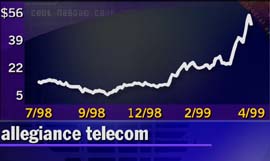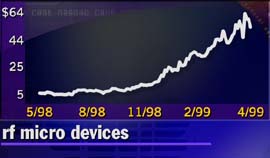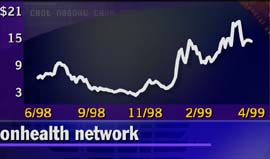|
Van Wagoner back on top
|
 |
April 30, 1999: 12:28 p.m. ET
Fund manager talks about his ups and downs and his favorite stock picks
|
NEW YORK (CNNfn) - Garrett Van Wagoner sounds pretty convincing when he says he's not elated to be back on top of the mutual fund mountain.
But it's hard to think that deep down he's not just a teeny bit euphoric after watching the Van Wagoner funds debut amid great expectations, then plunge for two years, and then soar once again to the top of the charts.
"In this business, you do go through cycles," Van Wagoner said in an interview this week. "At first you feel like you've figured out how the world works and you're never going to go down. And then the market changes and you feel like you'll never be back on top."
Van Wagoner, 43, is one of the marquis names in mutual funds.
A star hits hard times
When he left the stellar Govett Smaller Companies Fund in 1995 to form his own firm, eager investors followed him to cash in on what seemed to be brilliant stock picks. Assets ballooned to more than $1 billion within six months, setting a new record in the fund industry.
Six months later, small cap stocks went into a ghoulish bear market for two years, leaving many to question whether he was a good stock picker or simply good at picking what was hot.
His fortunes changed in the fall of 1998, and the Van Wagoner Technology, Emerging Growth and Post-Venture funds have remained in the top 10 list of performers all year among all U.S. stock funds tracked by fund researcher Morningstar. The other two funds in the fleet, Van Wagoner Micro-Cap and Mid-cap, aren't far behind.
"I'm not really elated, but I'm happy the shareholders are making money," Van Wagoner said during a telephone interview from his offices in downtown San Francisco.
But, he admits, it's better to be on top trying to figure out how to stay there, rather than to be on the bottom trying to figure a way out.
Some doubters remain
Chris Traulsen, an analyst at Morningstar, said Van Wagoner started having problems after he decided to cut the number of stocks he held in the funds from about 100 to about 60.
"He decided to focus on his best ideas…and some of those names blew up in his face," Traulsen said. "After that, he let the number of stocks go back up. He's let the Internet names ride up."
Traulsen said the funds are very risky -- and that clearly Van Wagoner has had "the wind at his back" in the times he's been on top.
"If you buy these funds you're betting on his ability to be in the right place at the right time," Traulsen said. "But to his credit, he's had some good picks in the Internet sector."
The Technology fund is up 79.69 percent year to date as of Thursday; while Emerging Growth is up 79.84 percent, Post-Venture is up 78.15 percent, Micro-Cap is up 47.79 percent and Mid-Cap is up 47.30 percent in the same time, according to Morningstar.
But Traulsen points out that Van Wagoner's long-term profits aren't so rosy. For example, the three-year average return for the Emerging Growth fund is just 10.60 percent and ranks in the 71st percentile.
"That isn't much, considering all the risks investors are taking," Traulsen said.
Climbing out of the bottom
How did Van Wagoner's luck change? The portfolios owned big stakes in Internet titans like Amazon.com (AMZN) and Yahoo! (YHOO) and technology giants like Dell (DELL) that delivered huge gains.
But Van Wagoner said the real push was from the smaller names that really took off in October 1998, such as Metromedia Fiber Network (MFNX), Covad Communications (COVD), Allegiance Telecom (ALGX), RF Micro Devices (RFMD) and TranSwitch (TXCC).

Fed Chairman Alan Greenspan also helped out when he lowered interest rates in September, October and November and reassured Wall Street that Asia wouldn't be a "smoking crater that sinks into the Pacific."
While the technology fund continues to own the big names like America Online (AOL), eBay (EBAY) and CMGI (CMGI) because there is no restriction on the size of the companies, Van Wagoner sold most of those stocks from the other portfolios.

Still, many of the portfolios own the same names, including OnHealth Network (ONHN), an online health news provider, and a stake in Web MD, which is planning an IPO. Microsoft is also rumored to be planning to buy a 27 percent stake in Web MD, Van Wagoner said. Other favorites include iVillage (IVIL), a women's online network.
"Our Internet theme is to move away from the big portals and commerce and move toward content and infrastructure," he said.

He sounds matter-of-fact when talking about the volatility of the Internet sector -- and the 'Internet bubble.' The funds' stake in Internet stocks has dropped dramatically.
"It's a very emotional group," Van Wagoner shrugs. "On the other hand, these stocks are going to change the world."

The reason for the overlapping stocks is the funds are all searching for young, aggressive companies that are poised to soar, he said. But the Post-Venture and Emerging Growth funds have spread out to include health care and consumer names. Emerging Growth is also looking at energy companies.
"They (the funds) are spreading out again because we see opportunities in other groups," Van Wagoner said.
For the future
Van Wagoner's heavy trading delivered a steep turnover rate of about 700 percent in 1998, and he promises almost as much action this year.
Traulsen called the turnover rate "incredibly high."
"It's difficult for you as an investor to know what you're owning at one time," Traulsen said.
Given the risk and performance problems in the past, Traulsen said investors might be better off with a diversified technology fund.
"He's really a fast-trading, aggressive manager," Traulsen said. "He's looking for the next hot thing."
Van Wagoner argues the turnover hasn't delivered a big tax hit to shareholders.
"If you looked at the returns I've generated (over the years) versus the taxes paid, you'd find we're pretty efficient relative to taxes," he said.
And Van Wagoner's outlook for emerging growth companies is bright, while he's "cautiously optimistic" on technology. His caution with technology has more to do with timing, since technology issues tend to not perform as well in summer months.
"I'm very bullish about emerging growth after going through one hellacious bear market," he said. "But given that bullishness, I'm also a realist. Because of our emerging growth philosophy, we own a lot of technology stocks. Tech stocks tend to take a rest through the summer and have a fairly strong fall and winter. So there's a little bit of a caution flag."
Yet Van Wagoner has obviously given some thought to the investors who chased after him and got stung when his funds didn't perform well. He says this market is different, and that it is at the start of a new cycle.
"As much as I feel bad for shareholders, I can't tell them when to get in and get out," he said. "Everybody should be diversified in a couple of different funds. People who were throwing money at us in 1996, that's not what we're all about. I'd say, humbly, that we should only be a percentage of your portfolio." 
-- by staff writer Martine Costello
|
|
|
|
|
 |

|

